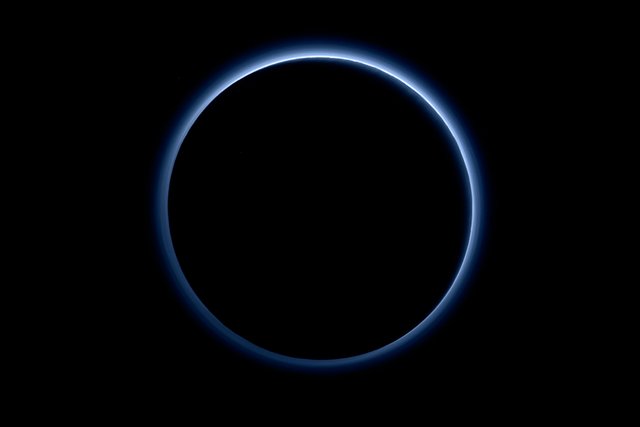A layer of haze keeps Pluto’s atmosphere extremely cold

It’s cold to start with, all that way from the sun. But at -203°C, the observed temperature of Pluto’s atmosphere is around 30 degrees colder than it should be theoretically. Now, the puzzle of why it’s colder than expected has been solved, and it comes down to the previously unappreciated shielding effects of tiny sooty particles that create a haze.
Previously, all calculations to explain Pluto’s chilly air have focused solely on gases such as methane rather than tiny, sooty particles. Gases dictate how the temperature of the atmosphere is controlled on all other planets in our solar system. On Earth, for example, we know that the greenhouse gas carbon dioxide has a central effect of warming the planet by trapping the sun’s heat.
Pluto is different, and it all comes down to soot. It starts with ultraviolet light from the sun smashing apart gas molecules like nitrogen and methane to create reactive ions. These recombine to create monomeric hydrocarbon molecules, which then flock together to form large, fractal aggregates that amount to soot.
Xi Zhang at the University of California at Santa Cruz and his team calculated the balance between how much solar radiation the soot particles absorb, and how much they then release back to space. “Basically, we needed a strong coolant to explain why Pluto is so cold,” he says. “We found that the abundant haze particles can strongly cool the atmosphere by re-emitting infrared radiation to space, a process not considered in previous theories.”

Atypical atmosphere
Haze particles also absorb solar energy to heat the atmosphere, but their cooling is stronger, so the net effect is cooling, says Zhang.
They find that the particles can absorb about 1 to 5 per cent of incoming solar energy, with the rest reflected back by Pluto’s surface. “In the infrared range of radiation, a slightly larger amount of energy is radiated back to space by the haze particles, cooling the atmosphere overall,” Zhang says.
Previous calculations had focused on methane, which can only absorb 0.3 per cent of the incoming energy, and whose heating and cooling rates are at least 10 times smaller than that of the soot. “I was very puzzled when I first did the calculations, as we’d not seen any atmosphere before in the solar system controlled by particles instead of gases,” says Zhang. “So Pluto’s atmosphere exhibits a new type of atmosphere on planets.”
Randy Gladstone at the Southwest Research Institute says, “They offer a very nice explanation for one of the most surprising of New Horizon’s discoveries about Pluto – that the upper atmosphere is much colder, and thus escaping to space much more slowly, than expected – by using another surprising discovery: Pluto’s global haze layer.”
Because the haze makes the infrared emissions from Pluto brighter, Zhang and his colleagues are hoping that their theoretical predictions will be confirmed next year with inauguration of the James Webb Space Telescope, a new instrument that can measure Pluto’s infrared footprint with sufficient resolution to detect the subtle impact of the soot.
Source : New Scientist

wow amazing back plz bro
done :D
wow
:D
kita mat mathio ???????////
Bhujlam na bhai :/
Hi! I am a robot. I just upvoted you! I found similar content that readers might be interested in:
https://www.newscientist.com/article/a-layer-of-haze-keeps-plutos-atmosphere-extremely-cold/
Congratulations @yasifalam! You have completed some achievement on Steemit and have been rewarded with new badge(s) :
Click on any badge to view your own Board of Honor on SteemitBoard.
For more information about SteemitBoard, click here
If you no longer want to receive notifications, reply to this comment with the word
STOP